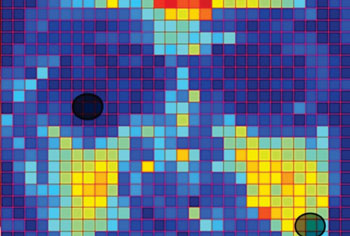Video System Monitors Patients’ Vital Signs
By HospiMedica International staff writers
Posted on 23 Apr 2015
A new camera-based estimation algorithm uses facial video to monitor a patient’s vital signs, adjusting for skin tones, lighting, and movement.Posted on 23 Apr 2015
DistancePPG, developed by researchers at Rice University (Houston, TX, USA), uses photoplethysmography (PPG) to measure a patient’s pulse and breathing by analyzing subtle changes in skin color over time, correcting for low-light conditions, dark skin tones, and movement. The system is based on algorithms that combine skin-color change signals from different tracked regions of the face using a weighted average, where the weights depend on the blood perfusion and incident light intensity in the region.

Image: Subtle changes in facial skin color highlighted on the app. (Photo courtesy of Mayank Kumar/Rice University).
One algorithm works by averaging skin-color change signals from different areas of the face; the other algorithm tracks the patient’s nose, eyes, mouth, and whole face. The combination improves the signal-to-noise ratio (SNR) of camera-based estimates of vital signs. The gains in SNR translate into reduction of the error in vital sign estimation, and thus expand the scope of camera-based vital sign monitoring to potentially challenging scenarios. The study describing DistancePPG is published in the May 2015 issue of Biomedical Optics Express.
“Our key finding was that the strength of the skin-color change signal is different in different regions of the face, so we developed a weighted-averaging algorithm,” said lead author PhD graduate student in electrical engineering Mayank Kumar. “It improved the accuracy of derived vital signs, rapidly expanding the scope, viability, reach and utility of camera-based vital-sign monitoring.”
The researchers claim that the system will allow doctors to diagnose patients from a distance, with special attention paid to those in low-resource settings. They also expect the software will soon find its way to mobile smartphones, tablets, and computers, so that people can reliably measure their own vital signs whenever and wherever they choose.
Related Links:
Rice University














